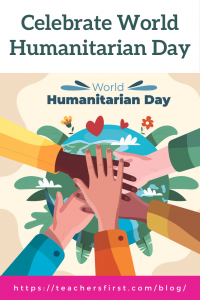We live in a world in which we need to share responsibility. It’s easy to say “It’s not my child, not my community, not my world, not my problem.” Then there are those who see the need and respond. I consider those people my heroes.
~Fred Rogers
Each year on August 19th, we celebrate World Humanitarian Day (WHD). It is a day both to honor humanitarian aid workers who have sacrificed their lives and to recognize and celebrate those impassioned, brave, selfless heroes who have answered the call to support people affected by global crises worldwide. According to the United Nations Office for the Coordination of Humanitarian Affairs (OCHA), World Humanitarian Day’s focus is “bringing together partners from across the humanitarian system to advocate for the survival, well-being, and dignity of people affected by crises, and for the safety and security of aid workers.” I hope this blog post can serve as a resource to help you connect your students to human welfare issues and consider how they can bring awareness to these issues.
If this is your first time highlighting World Humanitarian Day with students, check out this post highlighting 6 Ways To Celebrate World Humanitarian Day, or you can simply start by reviewing the purpose of this day. As a class, you can explore the United Nations OCHA Services WHD past campaigns page that shares multiple resources about prior themes and campaigns. Provide a space for students to share their thoughts on why a particular theme was pertinent. They can create a digital graffiti wall sharing their ideas using a Google Jamboard (reviewed here). Make a copy of this graffiti wall template by Kris Szajner to get them started. They could also engage in a thinking routine like See, Think, Wonder using this Jamboard template.
In 2020, the theme was #reallifeheroes, and OCHA created this collection of humanitarian stories. They took the stories of these powerful real-life heroes and made them into comics. Share some of these stories from the collection as a class and read the biography that follows. Then, depending on the needs of your students, you might let them navigate the rest of the site on their own or in collaborative groups. Students could then research real-life heroes they’re interested in (including someone they know personally) and create their comics using a tool like Make Beliefs Comix, highlighted in this Tech Tool of the Month post by Melissa Henning. Finally, in keeping with the concept of humanitarian aid workers as heroes, consider adapting the following lesson plans and voices from the field stories into your instruction:
- World Humanitarian Day: Voices from the Field
- Everyday Heroes: Beyoncé And United Nations World Humanitarian Day
- World Humanitarian Day Multimedia Resources and Lesson Plan for Teachers
There are also some inspiring stories out there about how schools and students embodied the essence of World Humanitarian Day by celebrating through acts of service and global connection. Here are a few of these motivating stories that you can share with your students.
- Global Citizen and Microsoft connect with classrooms around the world honoring ‘one humanity.’
- With World Humanitarian Day on August 19, students reflect on experiences helping communities in need.
- U of L students exemplify the spirit of World Humanitarian Day
What could it look like to empower your students to design an experience that honors this humanitarian campaign? Any one of these articles can serve as a springboard to a project-based learning unit, or you might even consider creating and performing a service learning project as a class. The possibilities are endless!
In the comments below, we’d love to hear any ideas you might have on how you help students build awareness of world issues and use their voices to be global advocates.


